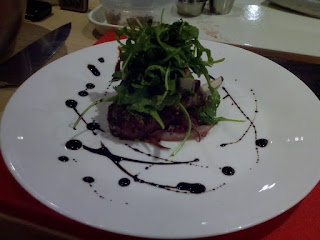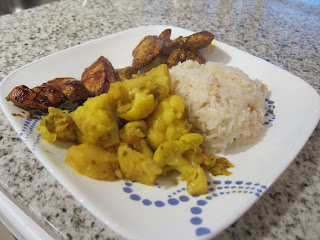Filling
- 1 lb ground pork
- 1 egg (can omit for fatty meat)
- canola oil
- sesame oil
- salt and pepper
- soya sauce
- 400 g chives (bunch should have 5 cm diameter)
- 1 thumb ginger
- 1 tsp Chinese cooking wine
- 2 fragrant mushrooms (shiitake)
 |
| Our mushrooms were dried, so we soaked them in water to rehydrate |
- Chop all filling ingredients finely and mix together.
 |
| The completed filling |
Wrapper
- 5-6 cups flour
- water
- Add flour to a bowl.
- Add 1 tbsp of water and mix. Keep adding water until fully moistened.
- Knead.
 |
| Dough ready for kneading |
- On a floured work surface, roll out half of dough into a long cylinder.
- Break in half lengthwise to make 2-3 cm thick.
- Break off 2 cm pieces from each half.
- Roll each piece into a ball.
- On a heavily floured work surface, roll out each ball with a rolling pin. You can roll the pin back and forth with one hand and rotate the dough with the other hand. This technique will give your wraps thin edges to make it easier to seal your dumplings.
- Hold a wrap on your fingers and add a scoop of filling.
- Fold the wrap in half and pinch the edges to seal the dumpling. You can wrinkle the pinched edge and press it together to make a crescent shape.
- Repeat until you've filled and sealed all of your wraps.
Now that you've made your dumplings, you can freeze them or cook them right away. You can either boil or fry your dumplings.
Boil
- Fill a pot with enough water to submerge your dumplings.
- Cover and bring to a boil on high heat.
- When water boils, add 1 cup cold water and bring to a boil again.
- Repeat this boil-add-water process until you've added 3 cups of water.
- Once it boils again, remove from heat.
- Remove dumplings with a slotted spoon and enjoy!
Fry
- Heat a pan and add 1 tbsp oil.
- Add your dumplings.
- Cook until bottoms are browned.
- Add enough water to cover the bottom of the pan.
- Cover and cook until done.








































